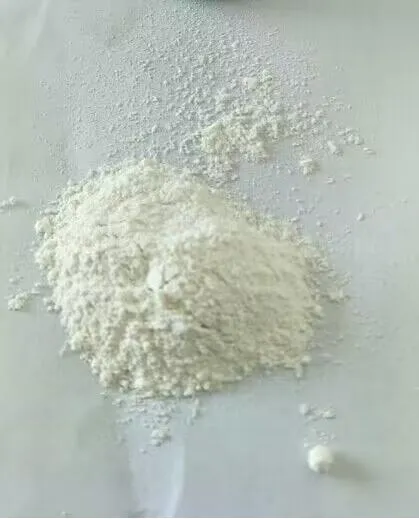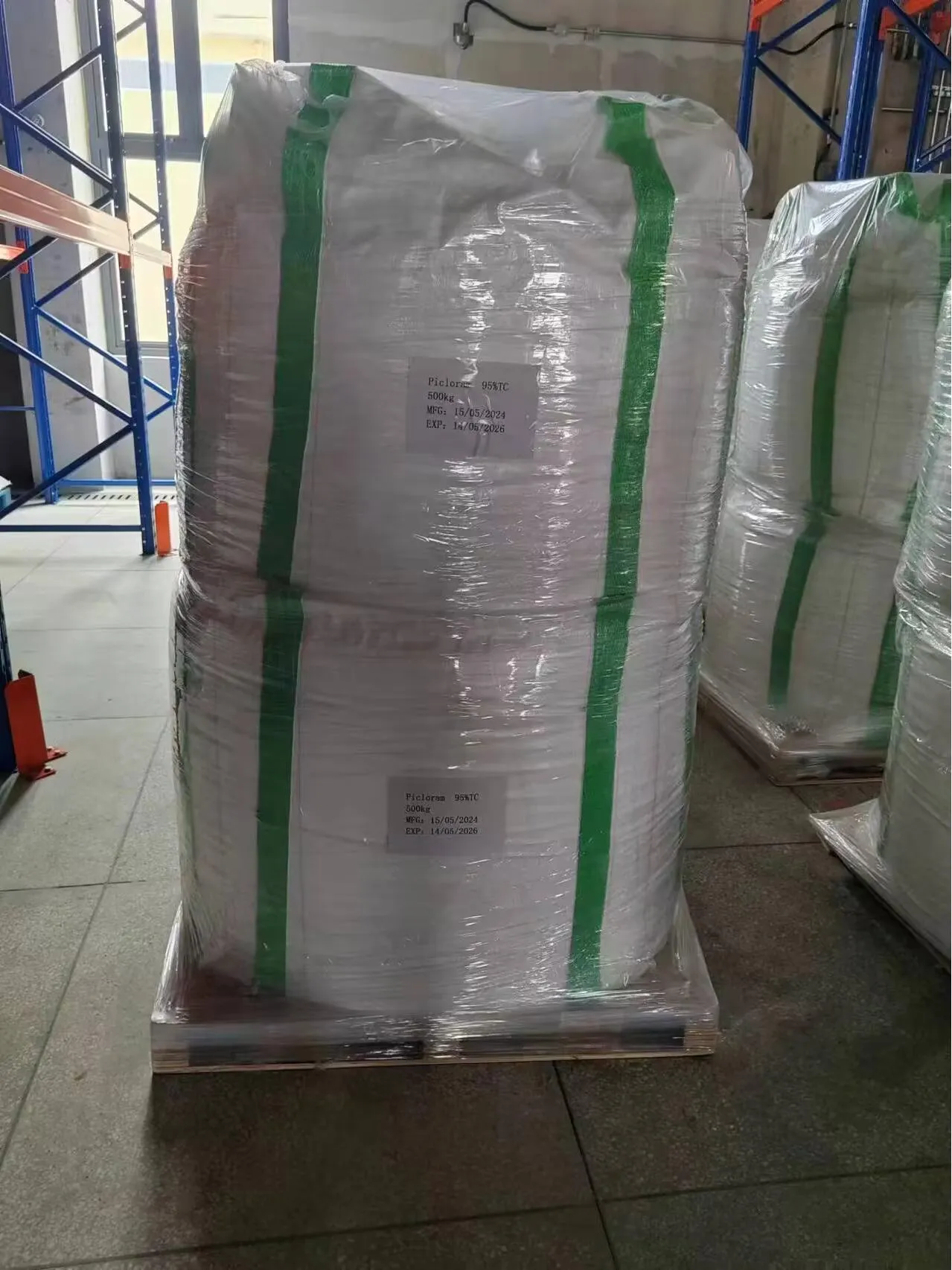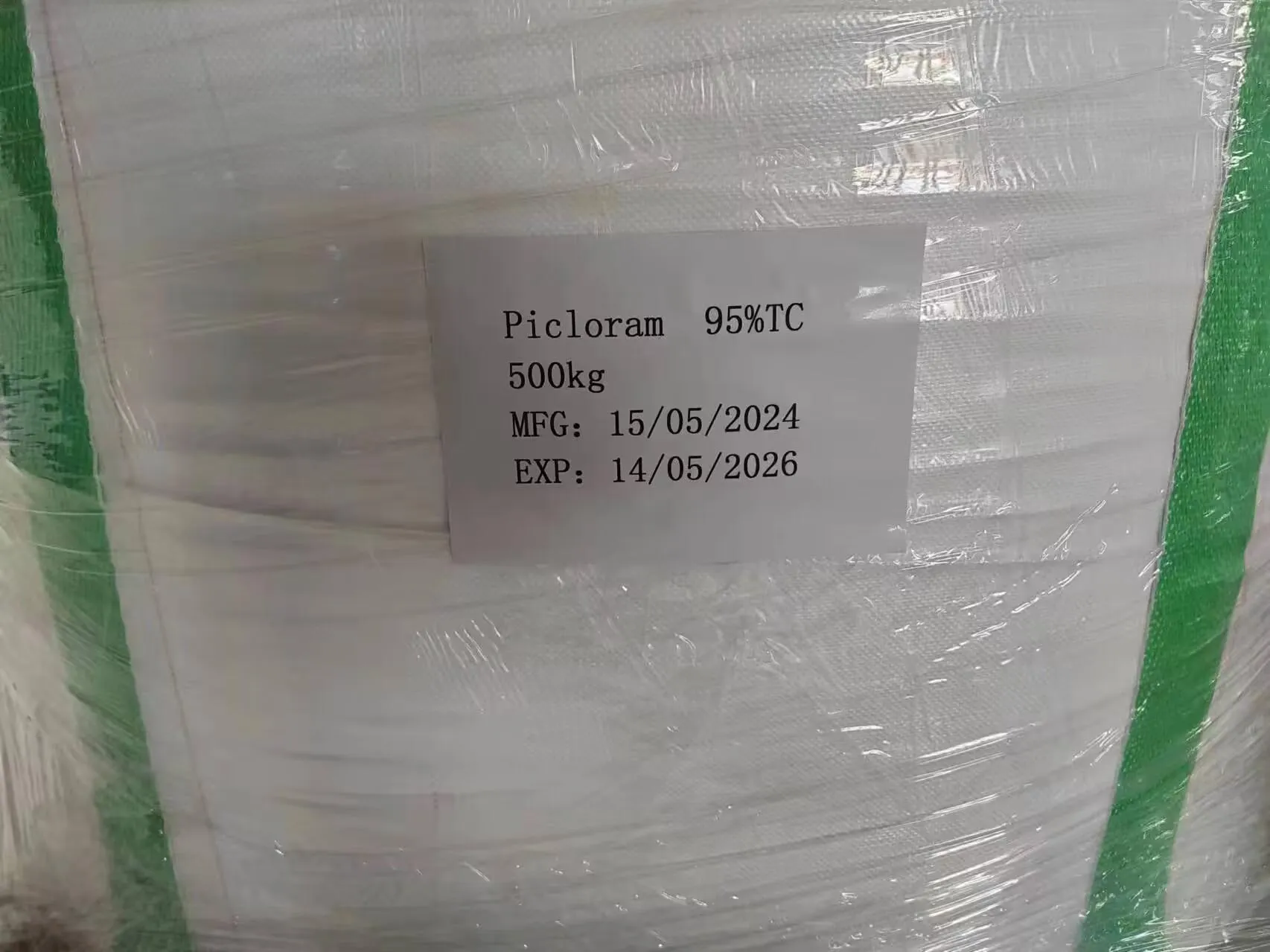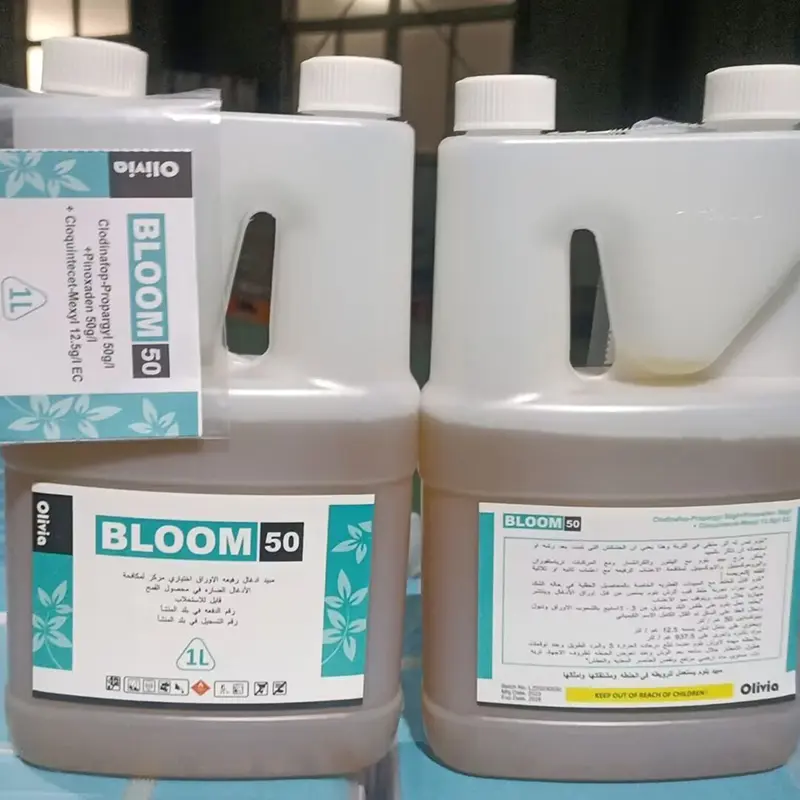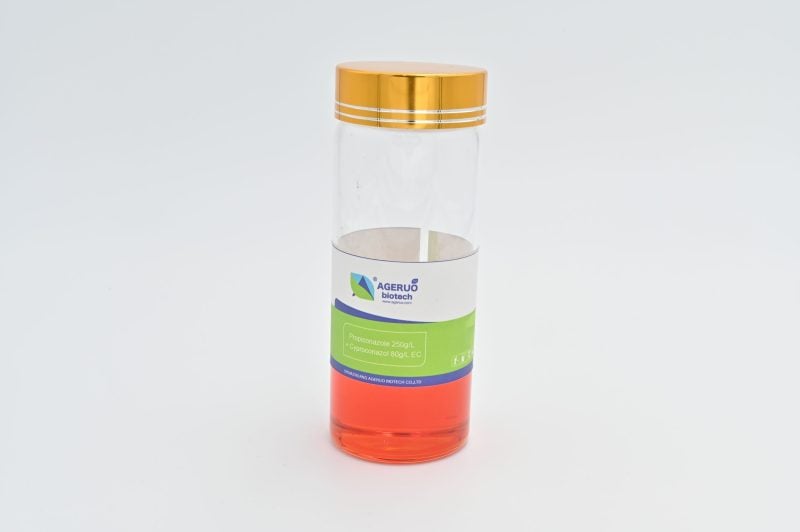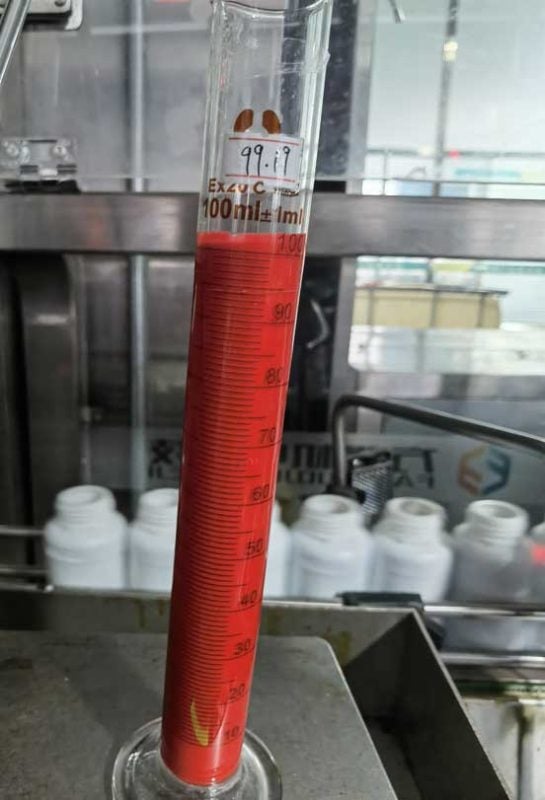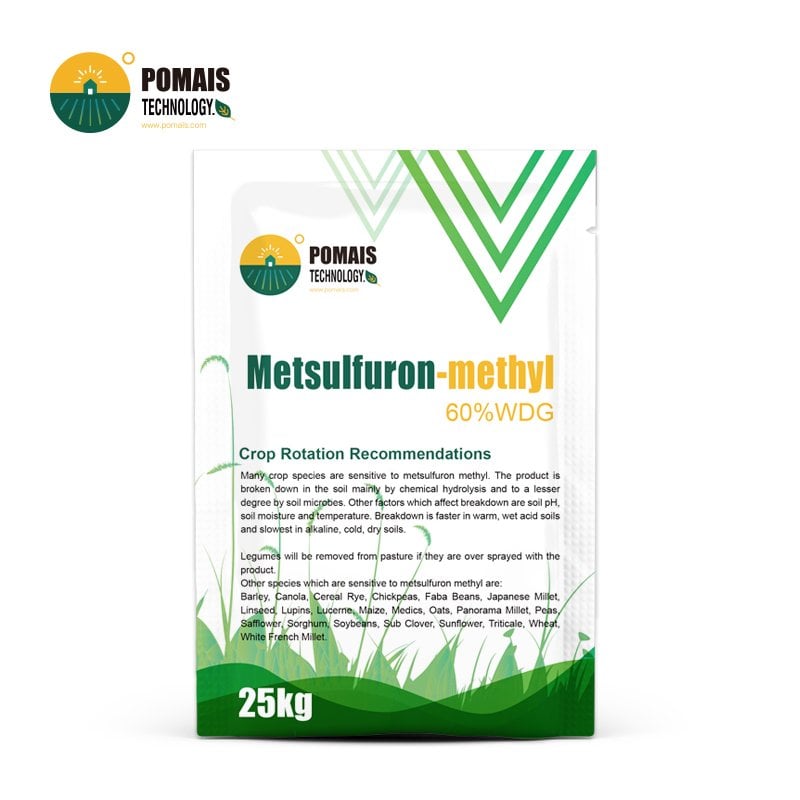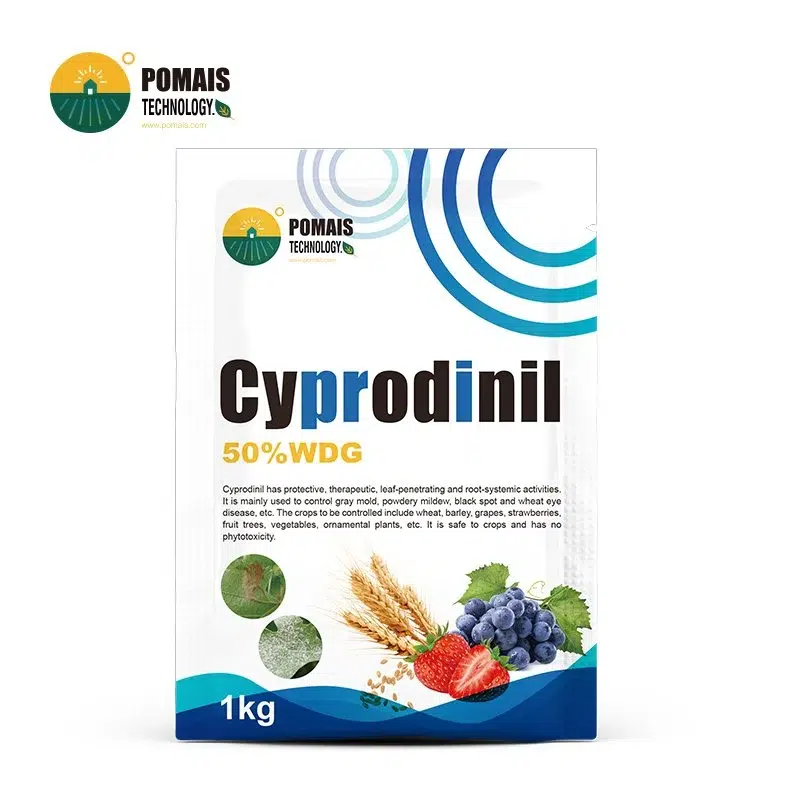Picloram Herbicide
Reliable Long-Term Control for Broadleaf Weeds and Woody Plants
If you are looking for a proven solution to tackle tough perennial broadleaf weeds, brush, and woody plants, Picloram herbicide is your trusted choice. Known for its strong soil residual activity and systemic mode of action, Picloram helps your growers clear invasive species in pastures, rangelands, forests, and non-crop areas.
At POMAIS, we supply a full range of Picloram formulations — from active ingredient raw material to popular combinations like Picloram + 2,4-D and Picloram + Triclopyr — all backed by strict quality control, OEM private labeling, and global registration support. Whether your market demands Tordon-type products, Picloram 22K, or custom blends, we are ready to help you serve your customers with confidence.
- Designed for Professional Buyers & Bulk Orders
- This product is available for business purchase and large-scale distribution.
- We support custom packaging, labeling, and formulation to meet your market needs.
- Let’s build your brand together.

About Picloram Herbicide
About Picloram Herbicide
| Product Name | Picloram Herbicide |
| Active Ingredient | Picloram (Pyridine carboxylic acid herbicide) |
| CAS Number | 1918-02-1 |
| Chemical Formula | C6H3Cl3N2O2 |
| Formulation Types | Picloram 22K, Picloram + 2,4-D, Picloram + Triclopyr, Picloram Technical |
| Mode of Action | Systemic growth regulator – mimics auxin hormones, causes uncontrolled cell division, kills weeds from roots up |
| Key Features | Deep soil residual control; long-lasting suppression of tough perennials & woody plants |
| Target Species | Canada thistle, leafy spurge, knapweed, mesquite, kudzu, prickly pear cactus, Russian olive, dense brush |
| Typical Uses | Rangeland, pasture management, forestry site prep, non-crop areas, utility corridors, industrial weed control |
| Recommended Rates | 0.25–1.5 kg a.i./ha depending on target species and site conditions |
| Formulation Stability | ISO-certified production; high purity; strong soil residual; uniform mixing for foliar or soil application |
| Packaging Options | 500 ml, 1 L bottles; 5–20 L drums for contractors; large IBCs/bulk for broad-acre rangeland or forestry use |
| OEM & Private Label | Multilingual labels, registration dossiers, custom branding, flexible carton or pallet configurations |
| Technical Guidance | Mixing instructions, tank mix compatibility (Picloram + 2,4-D / Triclopyr), resistance management best practices |
| Global Standards | ISO-certified manufacturing, strict batch traceability, full COA, MSDS, GLP data support for local registration |
| Flexible Supply Chain | Small trials to bulk export; stable seasonal supply for large-scale pasture, forestry & industrial weed management |
| Field Training | Support with practical scenarios, dosage guidelines, pre-grazing interval reminders, safe use & environmental advice |
Picloram Herbicide – Reliable Long-Term Control for Broadleaf Weeds and Woody Plants
Picloram is a powerful systemic pyridine carboxylic acid herbicide that provides long-term control of tough perennial broadleaf weeds, deep-rooted brush, and invasive woody plants. It works by mimicking natural plant growth hormones, causing uncontrolled cell division that ultimately kills target weeds from the roots up.
Your customers benefit from Picloram’s strong soil residual activity, which helps control regrowth season after season with fewer repeat applications compared to contact herbicides. This makes it a practical tool for use in rangeland management, pasture renovation, forest site preparation, non-crop areas, and industrial sites where persistent species like mesquite, kudzu, or prickly pear cactus can be especially problematic.
We offer a full range of Picloram products to match different local requirements and weed pressures, including:
- Picloram 22K: A popular formulation for pasture and brush control.
- Picloram + 2,4-D: A common tank mix or pre-mix that broadens the spectrum to cover additional broadleaf species.
- Picloram + Triclopyr: An effective combination for dense woody plant infestations.
- Picloram Technical: Available for formulators and local repacking.
Whether your customers are comparing Picloram vs Triclopyr, looking to rotate modes of action, or want to expand their brush management programs, you can supply them with a stable, high-purity product that meets local registration standards. With POMAIS, you also get full support for custom labeling, packaging, and multilingual documentation to stay competitive in diverse markets.
Mode of Action
Picloram herbicide works as a systemic, selective growth regulator that belongs to the pyridine carboxylic acid chemical family. Once applied, it is absorbed through the foliage and roots of target plants and then translocated throughout the vascular system, reaching new shoots, stems, and extensive root systems that are often missed by contact herbicides.
The active ingredient mimics natural auxin plant hormones, disrupting normal cell growth and division. This causes uncontrolled and abnormal growth patterns, twisting of stems, swelling of tissues, and eventual dieback. Deep-rooted perennial weeds and woody plants are especially vulnerable because Picloram’s strong residual activity in soil keeps working over time, suppressing regrowth and seedlings that may emerge later.
When you combine Picloram with other herbicides such as 2,4-D or Triclopyr, you expand the mode of action spectrum. For example:
- Picloram + 2,4-D provides quick knockdown plus residual control of tough broadleaf weeds.
- Picloram + Triclopyr is highly effective for managing dense brush, invasive shrubs, and trees that require deep systemic movement.
By explaining how Picloram works to your buyers, you help them position this herbicide as a long-term, cost-effective solution for challenging non-crop areas, rangeland weed infestations, and woody plant management.
Target Weeds & Typical Uses
When you offer Picloram herbicide, you help your customers tackle some of the most stubborn perennial broadleaf weeds, brush, and woody plants that standard contact herbicides often fail to manage. Picloram’s systemic and residual action makes it an ideal choice for areas that demand long-lasting control with fewer repeat treatments.
Typical Target Weeds and Species
Your growers can rely on Picloram to control:
- Deep-rooted perennial broadleaf weeds like Canada thistle, leafy spurge, and knapweed.
- Invasive brush species such as mesquite, kudzu, and Russian olive.
- Woody plants including certain trees, shrubs, and cacti (e.g., prickly pear cactus).
- Problematic species in rangeland, pastures, forest clearings, and non-crop rights-of-way.
Key Use Scenarios
Rangeland and Pasture Management:
Used alone or in combinations like Picloram + 2,4-D, Picloram helps keep grazing lands clear of invasive weeds and brush, improving forage availability and grazing efficiency.
Forestry and Brush Control:
When your customers deal with dense brush or tree regrowth, Picloram + Triclopyr or Picloram + 2,4-D can be applied for broad-spectrum suppression and residual soil activity that controls new shoots.
Non-Crop & Industrial Sites:
Picloram is widely used along fence lines, utility corridors, roadsides, and pipeline right-of-ways to maintain clear access and prevent encroachment of woody species that can cause long-term maintenance issues.
By providing clear recommendations on which weeds Picloram controls best and how to use it in real conditions, you help your buyers position your product as a practical, long-term solution for challenging vegetation management.
Recommended Dosage & Application
When you guide your customers on the correct use of Picloram herbicide, you help them maximize its long-term weed and brush control while protecting desirable vegetation and the environment.
Picloram is primarily used as a foliar spray or soil treatment for tough perennial weeds and woody plants. Your growers should always:
- Apply when target plants are actively growing and have full leaf coverage for maximum uptake.
- Use proper spray equipment to ensure even coverage and minimize drift.
- Respect buffer zones near sensitive crops or water bodies due to Picloram’s soil mobility.
When tank mixing with other actives like 2,4-D or Triclopyr, always recommend a jar test for compatibility and adjust rates according to local conditions and weed pressure.
Example Dosage & Application Guide
| Target Area | Target Species | Recommended Rate | Application Method |
|---|---|---|---|
| Pasture & Rangeland | Canada thistle, leafy spurge | 0.25 – 0.5 kg a.i./ha | Foliar spray with ground equipment |
| Brush & Woody Plants | Mesquite, kudzu, Russian olive | 0.5 – 1.0 kg a.i./ha | Foliar spray or basal bark treatment |
| Non-Crop & Industrial Land | Prickly pear cactus, dense brush regrowth | 1.0 – 1.5 kg a.i./ha (as needed) | Spot treatment, soil application |
| Tank Mix (Picloram + 2,4-D) | Mixed broadleaf and woody species | Adjust Picloram by 25–50% + standard 2,4-D rate | Foliar broadcast or spot spray |
Practical Tips
- Use under calm weather conditions to reduce drift.
- Avoid spraying when heavy rain is forecast within 24 hours.
- Observe pre-grazing or pre-harvest intervals if required by local regulations.
- Clean equipment thoroughly after use to prevent unintended damage to sensitive crops.
By giving clear dosage ranges and mixing guidance, you help your buyers deliver consistent results and maintain your reputation as a trusted herbicide partner.
Benefits & Grower Value
When you supply Picloram herbicide, you provide your customers with a cost-effective solution for tackling the most persistent broadleaf weeds and woody plants that standard herbicides often fail to control.
Long-Term Control for Fewer Repeat Applications
Because of its strong residual soil activity, Picloram helps growers suppress regrowth for extended periods. This reduces the need for multiple treatments within a single season, saving on labor, fuel, and equipment wear. For large rangeland or forestry operations, this means significant cost savings over time.
Proven Versatility Across Different Conditions
Whether applied alone or in tank mixes like Picloram + 2,4-D or Picloram + Triclopyr, your customers gain the flexibility to adapt control programs to match local weed pressures and land management goals. This makes it practical for pastures, brush-infested areas, right-of-ways, and industrial sites.
Boosted Land Productivity
By clearing aggressive brush and deep-rooted weeds, growers can reclaim valuable grazing land, improve forage quality, and support healthier livestock. For forest and utility managers, Picloram reduces long-term maintenance costs by preventing invasive regrowth that can interfere with operations.
Competitive Advantage with OEM Support
You also add value for distributors and importers by offering consistent batch quality, flexible packaging, and private label support. This helps your buyers maintain a professional brand image while delivering real field performance that builds repeat business.
When you position Picloram herbicide as part of your portfolio, you help your customers invest in a proven tool for sustainable vegetation management that protects yields, reduces labor, and keeps land in productive use for the long term.
Formulation Stability & Packaging Options
When you choose to distribute Picloram herbicide, you want to be certain your customers receive a formulation that stays stable from warehouse to field. With POMAIS, you can supply Picloram in a range of concentrations and combinations while ensuring consistent batch quality every time.
Proven Stability in Diverse Climates
Our Picloram products, whether supplied as technical material, Picloram 22K, or pre-mixes like Picloram + 2,4-D, are produced under strict ISO-certified conditions. Each batch is tested for purity, granule uniformity, and shelf life, ensuring it dissolves evenly and performs consistently even when stored in varying temperatures and humidity.
Your growers benefit from easy mixing, minimal tank residue, and reliable soil residual activity that does not degrade under normal storage and transport.
Flexible Packaging Options
To match different customer groups and local regulations, you can offer:
- Small retail packs (500 ml, 1 L bottles, or 1 kg foil bags)
- Medium bulk packs for contractors (5 L, 10 L, or 20 L drums)
- Large industrial drums or IBC tanks for broad-acre rangeland and forest operations
All containers are moisture-resistant and tamper-evident, giving your buyers confidence in product integrity from factory to farm.
OEM & Private Label Support
We know that branding and compliance are key to your success in competitive markets. That’s why you get full OEM and private label capabilities, including:
- Multilingual labels to fit different countries’ requirements
- Flexible carton or pallet configurations
- Registration dossiers and technical sheets to help speed up local approvals
When you offer Picloram herbicide with reliable formulation stability and professional packaging, you help your customers manage inventory efficiently and deliver field results that keep them coming back for repeat orders.
Tank Mix Compatibility & Resistance Management
When you help your customers use Picloram herbicide correctly, you give them practical options to expand their weed and brush control programs while keeping resistance issues under control.
Flexible Tank Mixing Options
Picloram is highly versatile and works well when tank mixed with other growth regulator herbicides like 2,4-D and Triclopyr. These combinations broaden the weed spectrum, adding quick knockdown for annual broadleaf weeds while Picloram provides deep residual control for perennials and woody species.
For best results, always recommend your buyers:
- Perform a small jar test to confirm physical compatibility before large-scale mixing.
- Follow local label rates for each active ingredient and adjust water volume for uniform coverage.
- Use well-maintained equipment to ensure even application and reduce the risk of overlap or drift.
Common tank mix combinations include:
- Picloram + 2,4-D: Widely used in pasture and rangeland management.
- Picloram + Triclopyr: Ideal for dense brush, trees, and invasive shrubs that require both foliar and root kill.
Sustainable Resistance Management
Overuse of a single herbicide mode of action can lead to resistant weed populations. By supplying Picloram herbicide, you help your customers rotate chemistries and integrate multiple modes of action into their weed management plans.
Encourage growers to:
- Alternate Picloram with other herbicide families when possible.
- Combine chemical control with cultural practices like mowing, grazing rotation, or targeted burning.
- Monitor fields regularly for signs of poor control that may indicate early resistance.
By giving clear tank mix and resistance management guidance, you position yourself as a knowledgeable partner who helps buyers get maximum value and protect their land investment for years to come.
Safety Measures & Environmental Impact
When you supply Picloram herbicide, you take on the responsibility of helping your customers use it safely and responsibly to protect their fields, workers, and the surrounding environment.
Safe Handling & PPE
Your buyers should always advise growers and contractors to wear proper personal protective equipment (PPE) when handling or applying Picloram. This includes:
- Chemical-resistant gloves and long-sleeved clothing.
- Eye protection and, where needed, a respirator when mixing large volumes.
- Washing hands and exposed skin thoroughly after handling.
Storing Picloram in its original, sealed containers in a dry, well-ventilated area helps maintain its stability and prevents accidental leaks or contamination.
Responsible Application Practices
Because Picloram has strong soil residual activity and can move in soil water, your growers should:
- Avoid application near desirable broadleaf crops or sensitive vegetation to prevent off-target injury.
- Observe local buffer zone regulations, especially near water bodies, wetlands, or drainage ditches.
- Use calibrated equipment to ensure uniform coverage and minimize overlap or drift.
It is also important to follow local pre-grazing or pre-harvest intervals where applicable, especially in pastures or rangelands where livestock may graze soon after treatment.
Proper Disposal & Environmental Stewardship
Remind your customers to triple rinse empty containers and dispose of them according to local agricultural chemical waste regulations. Never pour leftover spray mix into drains or water bodies.
By providing clear safety and environmental guidelines, you help your buyers demonstrate to their end users that your Picloram herbicide is part of a responsible vegetation management plan that controls invasive species without harming the surrounding ecosystem.
Field Use Scenarios
When you share clear, real-world examples of Picloram herbicide in use, you make it easier for your buyers to explain how to apply it effectively in the field and show its long-term value for land management.
Scenario 1: Pasture Weed Control with Picloram + 2,4-D
A rancher struggles with deep-rooted perennial broadleaf weeds like Canada thistle and leafy spurge spreading across grazing areas. They use Picloram + 2,4-D in a foliar broadcast application during the early growth stage when weeds are actively growing.
Result: The combination provides rapid knockdown from the 2,4-D plus extended soil residual control from Picloram, keeping weeds suppressed for the entire grazing season.
Scenario 2: Brush and Woody Plant Management with Picloram + Triclopyr
A forest maintenance contractor needs to clear invasive shrubs and regrowth of hardwood species along a right-of-way. They apply a tank mix of Picloram + Triclopyr using ground equipment for precise basal bark or foliar treatment.
Result: The systemic action reaches deep root systems, ensuring complete kill and reducing the need for frequent mechanical clearing.
Scenario 3: Cactus and Tough Woody Weeds in Rangeland
In semi-arid rangeland areas where prickly pear cactus has become a major problem, a landowner uses a high-rate Picloram herbicide spot treatment method. They apply it directly to the base of individual plants during active growth.
Result: The cactus plants die back completely over several months, freeing up grazing land and improving access for livestock.
Scenario 4: Industrial Sites and Utility Corridors
A utility company uses Picloram 22K for right-of-way vegetation management to prevent brush encroachment around pipelines and power lines. A single well-timed application each season keeps the corridor clear with minimal follow-up work.
Result: Maintenance costs decrease, and safe access for inspections and repairs is maintained year-round.
These scenarios show your buyers exactly how Picloram herbicide, alone or in combinations like Picloram + 2,4-D or Picloram + Triclopyr, delivers real results under practical field conditions. Sharing these examples makes your product more trusted and easier to recommend.
FAQ – Common Questions
Q1: What is Picloram herbicide used for?
You can use Picloram herbicide to control persistent perennial broadleaf weeds, woody brush, and invasive plants in rangeland, pastures, forest sites, and non-crop areas. It is especially valued for its long soil residual activity.
Q2: What is the difference between Picloram vs Triclopyr or Glyphosate?
Picloram is a selective systemic herbicide with strong soil residual control, ideal for brush and deep-rooted perennials. Triclopyr also controls woody species but breaks down more quickly in soil. Glyphosate is non-selective and provides no soil residual effect, so each fits different land management needs.
Q3: Can I mix Picloram with other herbicides?
Yes. Many growers and contractors use Picloram + 2,4-D or Picloram + Triclopyr tank mixes to broaden the weed spectrum. Always recommend doing a small jar test first to check physical compatibility.
Q4: Does Picloram affect grass or grazing animals?
When used as labeled, Picloram herbicide selectively targets broadleaf species and woody plants while leaving grasses largely unaffected. Always observe pre-grazing intervals if treating pastures where livestock will graze.
Q5: How should I store and handle Picloram?
Store Picloram in its original, sealed packaging in a dry, well-ventilated area. Wear proper PPE when mixing or spraying. Triple rinse empty containers and dispose of them following local chemical waste rules.
Q6: What packaging sizes can you supply?
We offer flexible packaging including small retail bottles, mid-size contractor drums, and bulk IBCs. Private label and OEM options are available so you can adapt to local market needs.
Q7: How do I get Picloram herbicide pricing or request a sample?
Contact our team to get your latest Picloram herbicide price list, request free samples for performance testing, or ask about custom registration support for your region.
Why Choose POMAIS
When you choose POMAIS as your Picloram herbicide partner, you get more than just a product — you gain a trusted manufacturing and export team ready to help you grow your market with confidence.
Our Picloram formulations, including technical grade, Picloram 22K, and proven combinations like Picloram + 2,4-D or Picloram + Triclopyr, are produced under strict ISO-certified processes with full batch traceability. This ensures every drum, bottle, or bag meets your quality standards for storage stability, residual control, and consistent field performance.
Whether you need multilingual labels, private branding, or local registration support, we deliver complete OEM solutions so you can adapt to your region’s specific regulatory requirements and customer expectations.
If you are looking for a reliable supply of Picloram herbicide to tackle tough brush, woody plants, and persistent perennial weeds, talk to us today. Request your custom price quote, ask for free samples, or get support from our technical team to plan your next bulk shipment.
Let’s help you provide your growers and contractors with the long-term weed control they expect — season after season.
| Product Name | Picloram Herbicide |
| Active Ingredient | Picloram (Pyridine carboxylic acid herbicide) |
| CAS Number | 1918-02-1 |
| Chemical Formula | C6H3Cl3N2O2 |
| Formulation Types | Picloram 22K, Picloram + 2,4-D, Picloram + Triclopyr, Picloram Technical |
| Mode of Action | Systemic growth regulator – mimics auxin hormones, causes uncontrolled cell division, kills weeds from roots up |
| Key Features | Deep soil residual control; long-lasting suppression of tough perennials & woody plants |
| Target Species | Canada thistle, leafy spurge, knapweed, mesquite, kudzu, prickly pear cactus, Russian olive, dense brush |
| Typical Uses | Rangeland, pasture management, forestry site prep, non-crop areas, utility corridors, industrial weed control |
| Recommended Rates | 0.25–1.5 kg a.i./ha depending on target species and site conditions |
| Formulation Stability | ISO-certified production; high purity; strong soil residual; uniform mixing for foliar or soil application |
| Packaging Options | 500 ml, 1 L bottles; 5–20 L drums for contractors; large IBCs/bulk for broad-acre rangeland or forestry use |
| OEM & Private Label | Multilingual labels, registration dossiers, custom branding, flexible carton or pallet configurations |
| Technical Guidance | Mixing instructions, tank mix compatibility (Picloram + 2,4-D / Triclopyr), resistance management best practices |
| Global Standards | ISO-certified manufacturing, strict batch traceability, full COA, MSDS, GLP data support for local registration |
| Flexible Supply Chain | Small trials to bulk export; stable seasonal supply for large-scale pasture, forestry & industrial weed management |
| Field Training | Support with practical scenarios, dosage guidelines, pre-grazing interval reminders, safe use & environmental advice |
Picloram Herbicide – Reliable Long-Term Control for Broadleaf Weeds and Woody Plants
Picloram is a powerful systemic pyridine carboxylic acid herbicide that provides long-term control of tough perennial broadleaf weeds, deep-rooted brush, and invasive woody plants. It works by mimicking natural plant growth hormones, causing uncontrolled cell division that ultimately kills target weeds from the roots up.
Your customers benefit from Picloram’s strong soil residual activity, which helps control regrowth season after season with fewer repeat applications compared to contact herbicides. This makes it a practical tool for use in rangeland management, pasture renovation, forest site preparation, non-crop areas, and industrial sites where persistent species like mesquite, kudzu, or prickly pear cactus can be especially problematic.
We offer a full range of Picloram products to match different local requirements and weed pressures, including:
- Picloram 22K: A popular formulation for pasture and brush control.
- Picloram + 2,4-D: A common tank mix or pre-mix that broadens the spectrum to cover additional broadleaf species.
- Picloram + Triclopyr: An effective combination for dense woody plant infestations.
- Picloram Technical: Available for formulators and local repacking.
Whether your customers are comparing Picloram vs Triclopyr, looking to rotate modes of action, or want to expand their brush management programs, you can supply them with a stable, high-purity product that meets local registration standards. With POMAIS, you also get full support for custom labeling, packaging, and multilingual documentation to stay competitive in diverse markets.
Mode of Action
Picloram herbicide works as a systemic, selective growth regulator that belongs to the pyridine carboxylic acid chemical family. Once applied, it is absorbed through the foliage and roots of target plants and then translocated throughout the vascular system, reaching new shoots, stems, and extensive root systems that are often missed by contact herbicides.
The active ingredient mimics natural auxin plant hormones, disrupting normal cell growth and division. This causes uncontrolled and abnormal growth patterns, twisting of stems, swelling of tissues, and eventual dieback. Deep-rooted perennial weeds and woody plants are especially vulnerable because Picloram’s strong residual activity in soil keeps working over time, suppressing regrowth and seedlings that may emerge later.
When you combine Picloram with other herbicides such as 2,4-D or Triclopyr, you expand the mode of action spectrum. For example:
- Picloram + 2,4-D provides quick knockdown plus residual control of tough broadleaf weeds.
- Picloram + Triclopyr is highly effective for managing dense brush, invasive shrubs, and trees that require deep systemic movement.
By explaining how Picloram works to your buyers, you help them position this herbicide as a long-term, cost-effective solution for challenging non-crop areas, rangeland weed infestations, and woody plant management.
Target Weeds & Typical Uses
When you offer Picloram herbicide, you help your customers tackle some of the most stubborn perennial broadleaf weeds, brush, and woody plants that standard contact herbicides often fail to manage. Picloram’s systemic and residual action makes it an ideal choice for areas that demand long-lasting control with fewer repeat treatments.
Typical Target Weeds and Species
Your growers can rely on Picloram to control:
- Deep-rooted perennial broadleaf weeds like Canada thistle, leafy spurge, and knapweed.
- Invasive brush species such as mesquite, kudzu, and Russian olive.
- Woody plants including certain trees, shrubs, and cacti (e.g., prickly pear cactus).
- Problematic species in rangeland, pastures, forest clearings, and non-crop rights-of-way.
Key Use Scenarios
Rangeland and Pasture Management:
Used alone or in combinations like Picloram + 2,4-D, Picloram helps keep grazing lands clear of invasive weeds and brush, improving forage availability and grazing efficiency.
Forestry and Brush Control:
When your customers deal with dense brush or tree regrowth, Picloram + Triclopyr or Picloram + 2,4-D can be applied for broad-spectrum suppression and residual soil activity that controls new shoots.
Non-Crop & Industrial Sites:
Picloram is widely used along fence lines, utility corridors, roadsides, and pipeline right-of-ways to maintain clear access and prevent encroachment of woody species that can cause long-term maintenance issues.
By providing clear recommendations on which weeds Picloram controls best and how to use it in real conditions, you help your buyers position your product as a practical, long-term solution for challenging vegetation management.
Recommended Dosage & Application
When you guide your customers on the correct use of Picloram herbicide, you help them maximize its long-term weed and brush control while protecting desirable vegetation and the environment.
Picloram is primarily used as a foliar spray or soil treatment for tough perennial weeds and woody plants. Your growers should always:
- Apply when target plants are actively growing and have full leaf coverage for maximum uptake.
- Use proper spray equipment to ensure even coverage and minimize drift.
- Respect buffer zones near sensitive crops or water bodies due to Picloram’s soil mobility.
When tank mixing with other actives like 2,4-D or Triclopyr, always recommend a jar test for compatibility and adjust rates according to local conditions and weed pressure.
Example Dosage & Application Guide
| Target Area | Target Species | Recommended Rate | Application Method |
|---|---|---|---|
| Pasture & Rangeland | Canada thistle, leafy spurge | 0.25 – 0.5 kg a.i./ha | Foliar spray with ground equipment |
| Brush & Woody Plants | Mesquite, kudzu, Russian olive | 0.5 – 1.0 kg a.i./ha | Foliar spray or basal bark treatment |
| Non-Crop & Industrial Land | Prickly pear cactus, dense brush regrowth | 1.0 – 1.5 kg a.i./ha (as needed) | Spot treatment, soil application |
| Tank Mix (Picloram + 2,4-D) | Mixed broadleaf and woody species | Adjust Picloram by 25–50% + standard 2,4-D rate | Foliar broadcast or spot spray |
Practical Tips
- Use under calm weather conditions to reduce drift.
- Avoid spraying when heavy rain is forecast within 24 hours.
- Observe pre-grazing or pre-harvest intervals if required by local regulations.
- Clean equipment thoroughly after use to prevent unintended damage to sensitive crops.
By giving clear dosage ranges and mixing guidance, you help your buyers deliver consistent results and maintain your reputation as a trusted herbicide partner.
Benefits & Grower Value
When you supply Picloram herbicide, you provide your customers with a cost-effective solution for tackling the most persistent broadleaf weeds and woody plants that standard herbicides often fail to control.
Long-Term Control for Fewer Repeat Applications
Because of its strong residual soil activity, Picloram helps growers suppress regrowth for extended periods. This reduces the need for multiple treatments within a single season, saving on labor, fuel, and equipment wear. For large rangeland or forestry operations, this means significant cost savings over time.
Proven Versatility Across Different Conditions
Whether applied alone or in tank mixes like Picloram + 2,4-D or Picloram + Triclopyr, your customers gain the flexibility to adapt control programs to match local weed pressures and land management goals. This makes it practical for pastures, brush-infested areas, right-of-ways, and industrial sites.
Boosted Land Productivity
By clearing aggressive brush and deep-rooted weeds, growers can reclaim valuable grazing land, improve forage quality, and support healthier livestock. For forest and utility managers, Picloram reduces long-term maintenance costs by preventing invasive regrowth that can interfere with operations.
Competitive Advantage with OEM Support
You also add value for distributors and importers by offering consistent batch quality, flexible packaging, and private label support. This helps your buyers maintain a professional brand image while delivering real field performance that builds repeat business.
When you position Picloram herbicide as part of your portfolio, you help your customers invest in a proven tool for sustainable vegetation management that protects yields, reduces labor, and keeps land in productive use for the long term.
Formulation Stability & Packaging Options
When you choose to distribute Picloram herbicide, you want to be certain your customers receive a formulation that stays stable from warehouse to field. With POMAIS, you can supply Picloram in a range of concentrations and combinations while ensuring consistent batch quality every time.
Proven Stability in Diverse Climates
Our Picloram products, whether supplied as technical material, Picloram 22K, or pre-mixes like Picloram + 2,4-D, are produced under strict ISO-certified conditions. Each batch is tested for purity, granule uniformity, and shelf life, ensuring it dissolves evenly and performs consistently even when stored in varying temperatures and humidity.
Your growers benefit from easy mixing, minimal tank residue, and reliable soil residual activity that does not degrade under normal storage and transport.
Flexible Packaging Options
To match different customer groups and local regulations, you can offer:
- Small retail packs (500 ml, 1 L bottles, or 1 kg foil bags)
- Medium bulk packs for contractors (5 L, 10 L, or 20 L drums)
- Large industrial drums or IBC tanks for broad-acre rangeland and forest operations
All containers are moisture-resistant and tamper-evident, giving your buyers confidence in product integrity from factory to farm.
OEM & Private Label Support
We know that branding and compliance are key to your success in competitive markets. That’s why you get full OEM and private label capabilities, including:
- Multilingual labels to fit different countries’ requirements
- Flexible carton or pallet configurations
- Registration dossiers and technical sheets to help speed up local approvals
When you offer Picloram herbicide with reliable formulation stability and professional packaging, you help your customers manage inventory efficiently and deliver field results that keep them coming back for repeat orders.
Tank Mix Compatibility & Resistance Management
When you help your customers use Picloram herbicide correctly, you give them practical options to expand their weed and brush control programs while keeping resistance issues under control.
Flexible Tank Mixing Options
Picloram is highly versatile and works well when tank mixed with other growth regulator herbicides like 2,4-D and Triclopyr. These combinations broaden the weed spectrum, adding quick knockdown for annual broadleaf weeds while Picloram provides deep residual control for perennials and woody species.
For best results, always recommend your buyers:
- Perform a small jar test to confirm physical compatibility before large-scale mixing.
- Follow local label rates for each active ingredient and adjust water volume for uniform coverage.
- Use well-maintained equipment to ensure even application and reduce the risk of overlap or drift.
Common tank mix combinations include:
- Picloram + 2,4-D: Widely used in pasture and rangeland management.
- Picloram + Triclopyr: Ideal for dense brush, trees, and invasive shrubs that require both foliar and root kill.
Sustainable Resistance Management
Overuse of a single herbicide mode of action can lead to resistant weed populations. By supplying Picloram herbicide, you help your customers rotate chemistries and integrate multiple modes of action into their weed management plans.
Encourage growers to:
- Alternate Picloram with other herbicide families when possible.
- Combine chemical control with cultural practices like mowing, grazing rotation, or targeted burning.
- Monitor fields regularly for signs of poor control that may indicate early resistance.
By giving clear tank mix and resistance management guidance, you position yourself as a knowledgeable partner who helps buyers get maximum value and protect their land investment for years to come.
Safety Measures & Environmental Impact
When you supply Picloram herbicide, you take on the responsibility of helping your customers use it safely and responsibly to protect their fields, workers, and the surrounding environment.
Safe Handling & PPE
Your buyers should always advise growers and contractors to wear proper personal protective equipment (PPE) when handling or applying Picloram. This includes:
- Chemical-resistant gloves and long-sleeved clothing.
- Eye protection and, where needed, a respirator when mixing large volumes.
- Washing hands and exposed skin thoroughly after handling.
Storing Picloram in its original, sealed containers in a dry, well-ventilated area helps maintain its stability and prevents accidental leaks or contamination.
Responsible Application Practices
Because Picloram has strong soil residual activity and can move in soil water, your growers should:
- Avoid application near desirable broadleaf crops or sensitive vegetation to prevent off-target injury.
- Observe local buffer zone regulations, especially near water bodies, wetlands, or drainage ditches.
- Use calibrated equipment to ensure uniform coverage and minimize overlap or drift.
It is also important to follow local pre-grazing or pre-harvest intervals where applicable, especially in pastures or rangelands where livestock may graze soon after treatment.
Proper Disposal & Environmental Stewardship
Remind your customers to triple rinse empty containers and dispose of them according to local agricultural chemical waste regulations. Never pour leftover spray mix into drains or water bodies.
By providing clear safety and environmental guidelines, you help your buyers demonstrate to their end users that your Picloram herbicide is part of a responsible vegetation management plan that controls invasive species without harming the surrounding ecosystem.
Field Use Scenarios
When you share clear, real-world examples of Picloram herbicide in use, you make it easier for your buyers to explain how to apply it effectively in the field and show its long-term value for land management.
Scenario 1: Pasture Weed Control with Picloram + 2,4-D
A rancher struggles with deep-rooted perennial broadleaf weeds like Canada thistle and leafy spurge spreading across grazing areas. They use Picloram + 2,4-D in a foliar broadcast application during the early growth stage when weeds are actively growing.
Result: The combination provides rapid knockdown from the 2,4-D plus extended soil residual control from Picloram, keeping weeds suppressed for the entire grazing season.
Scenario 2: Brush and Woody Plant Management with Picloram + Triclopyr
A forest maintenance contractor needs to clear invasive shrubs and regrowth of hardwood species along a right-of-way. They apply a tank mix of Picloram + Triclopyr using ground equipment for precise basal bark or foliar treatment.
Result: The systemic action reaches deep root systems, ensuring complete kill and reducing the need for frequent mechanical clearing.
Scenario 3: Cactus and Tough Woody Weeds in Rangeland
In semi-arid rangeland areas where prickly pear cactus has become a major problem, a landowner uses a high-rate Picloram herbicide spot treatment method. They apply it directly to the base of individual plants during active growth.
Result: The cactus plants die back completely over several months, freeing up grazing land and improving access for livestock.
Scenario 4: Industrial Sites and Utility Corridors
A utility company uses Picloram 22K for right-of-way vegetation management to prevent brush encroachment around pipelines and power lines. A single well-timed application each season keeps the corridor clear with minimal follow-up work.
Result: Maintenance costs decrease, and safe access for inspections and repairs is maintained year-round.
These scenarios show your buyers exactly how Picloram herbicide, alone or in combinations like Picloram + 2,4-D or Picloram + Triclopyr, delivers real results under practical field conditions. Sharing these examples makes your product more trusted and easier to recommend.
FAQ – Common Questions
Q1: What is Picloram herbicide used for?
You can use Picloram herbicide to control persistent perennial broadleaf weeds, woody brush, and invasive plants in rangeland, pastures, forest sites, and non-crop areas. It is especially valued for its long soil residual activity.
Q2: What is the difference between Picloram vs Triclopyr or Glyphosate?
Picloram is a selective systemic herbicide with strong soil residual control, ideal for brush and deep-rooted perennials. Triclopyr also controls woody species but breaks down more quickly in soil. Glyphosate is non-selective and provides no soil residual effect, so each fits different land management needs.
Q3: Can I mix Picloram with other herbicides?
Yes. Many growers and contractors use Picloram + 2,4-D or Picloram + Triclopyr tank mixes to broaden the weed spectrum. Always recommend doing a small jar test first to check physical compatibility.
Q4: Does Picloram affect grass or grazing animals?
When used as labeled, Picloram herbicide selectively targets broadleaf species and woody plants while leaving grasses largely unaffected. Always observe pre-grazing intervals if treating pastures where livestock will graze.
Q5: How should I store and handle Picloram?
Store Picloram in its original, sealed packaging in a dry, well-ventilated area. Wear proper PPE when mixing or spraying. Triple rinse empty containers and dispose of them following local chemical waste rules.
Q6: What packaging sizes can you supply?
We offer flexible packaging including small retail bottles, mid-size contractor drums, and bulk IBCs. Private label and OEM options are available so you can adapt to local market needs.
Q7: How do I get Picloram herbicide pricing or request a sample?
Contact our team to get your latest Picloram herbicide price list, request free samples for performance testing, or ask about custom registration support for your region.
Why Choose POMAIS
When you choose POMAIS as your Picloram herbicide partner, you get more than just a product — you gain a trusted manufacturing and export team ready to help you grow your market with confidence.
Our Picloram formulations, including technical grade, Picloram 22K, and proven combinations like Picloram + 2,4-D or Picloram + Triclopyr, are produced under strict ISO-certified processes with full batch traceability. This ensures every drum, bottle, or bag meets your quality standards for storage stability, residual control, and consistent field performance.
Whether you need multilingual labels, private branding, or local registration support, we deliver complete OEM solutions so you can adapt to your region’s specific regulatory requirements and customer expectations.
If you are looking for a reliable supply of Picloram herbicide to tackle tough brush, woody plants, and persistent perennial weeds, talk to us today. Request your custom price quote, ask for free samples, or get support from our technical team to plan your next bulk shipment.
Let’s help you provide your growers and contractors with the long-term weed control they expect — season after season.
Related Products
Latest News

